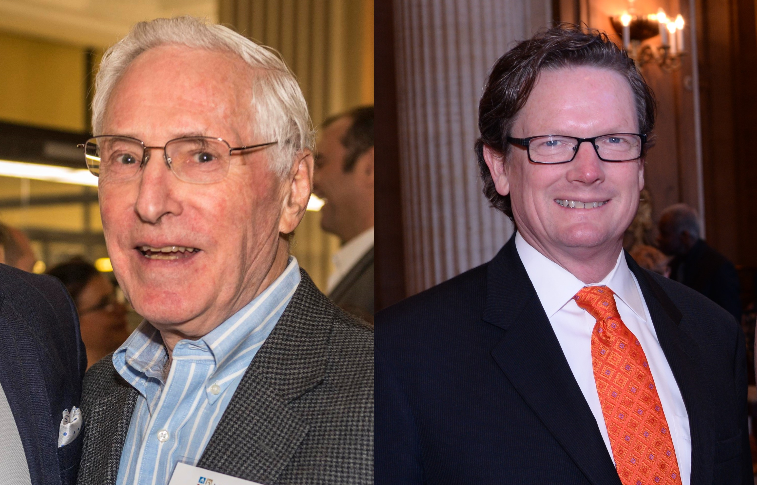(Photo: Martin Tangora (left) and Will Tippens)
March 9, 2021
(This article was originally published in the February 2021 edition of The Arch newsletter.)
Martin Tangora was among Landmarks Illinois first board members when the organization formed in 1971. He also served as its President in 1976. Will Tippens first got involved in Landmarks Illinois in the early 1980s when he interned with the organization. He later served as Board President from 2015 to 2017. Both Martin & Will currently serve on the Landmarks Illinois Board of Directors, and Will leads the organization’s 50th Anniversary Task Force.
We invited Martin & Will to ask each other about their decades of experience volunteering and helping Landmarks Illinois carry out its mission. Below are their interviews with each other.
Martin Tangora: When and how did you realize you wanted a life devoted to architecture, building and preservation?
WILL TIPPENS: No question my interest in architecture and preservation came from my father, Bill, who was an architect. I loved visiting his office to see the firm’s work and going with my dad to the job sites and see the buildings under construction. My father also loved Chicago architecture. He would give slide lectures at local grade schools on the Chicago School of Architecture and photograph the buildings on weekends. One of my very first summer jobs was around 1980, when I had a brief, unpaid internship with Landmarks Illinois. I helped do research on the mansions that would become the Seven Houses on Lake Shore Drive district.
MT: What victory or victories in preservation (or development) are you most proud of?
WT: It was during my first job out of grad school creating a new culture of preservation, with the help of Julia Bachrach, by establishing the preservation program at the Chicago Park District with Ed Uhlir. One of my roles in this was partnering with trades people on completing work orders on the park’s historic structures. I was a long haired, wet-behind-the-ears recent grad, and needless to say, I was not someone many of the trade workers were interested in listening to or working with. But over the four years I was at the Park District we worked together to find solutions for the trades to implement that were more appropriate to the buildings. By the time I left, I would often get calls from trades people before I even saw the work order list asking me to meet them at a fieldhouse to come up with a solution. We’d become a bit of a team that helped to elevate these important historic resources.

(Photo: Will Tippens at the 2016 Richard H. Driehaus Foundation Preservation Awards)
MT: What losses or other things are you most disappointed in?
WT: The losses that disappoint me the most are those that could have been avoided. Pilgrim Baptist Church, which was lost to a preventable fire is the first that comes to mind.
MT: What do you hope your personal legacy will be — with Landmarks Illinois or in the world of architecture and preservation?
WT: I’ve never really thought about legacy. I hope only that I’ve made a contribution to the field and the organization.
 (Photo: Marty Tangora shares a story with architect John Vinci during a Landmarks Illinois tour in 2020 of a special Chicago Stock Exchange Trading Room exhibit at the Art Institute of Chicago)
(Photo: Marty Tangora shares a story with architect John Vinci during a Landmarks Illinois tour in 2020 of a special Chicago Stock Exchange Trading Room exhibit at the Art Institute of Chicago)
Will Tippens: What first got a mathematician interested in preservation?
MARTIN TANGORA: Short answer: I was always interested in preservation. Long answer: As an undergrad at Caltech, editor of the student newspaper and of the humor magazine, I wrote lots of articles and editorials about how the Institute was not respecting its campus architecture (and plan). At the time, I didn’t have any knowledge, just instinct. As a Fulbright scholar in Paris, I studied the history of art and architecture — mostly French, of course. When the Republic Building was torn down, a newspaper article talked about the Chicago School, and I knew nothing about that, but saw that I had a gap to fill. I became a drinking friend of Carl Condit, so naturally I read his books. The loss of the Italian Court on North Michigan Avenue was tragic for me. By the time the Old Stock Exchange was in jeopardy, I was well informed and intensely concerned.
WT: When you joined the Landmarks Preservation Council of Illinois what were the preservation issues that were the focus of the organization at that time?
MT: The Stock Exchange, other Adler & Sullivan-designed buildings and then the Marquette Building a year later. Richard Miller (Landmarks Illinois’ founder) had me organize the Inventory, which was our (published) list of the buildings in the Chicago Central Area that we wanted developers to know that we would fight to protect.
WT: What are the biggest changes you’ve seen in the organization and the preservation movement in the past 50 years?
MT: Displacement of volunteers by professionals with advanced degrees not just in architectural history but in preservation. Actually I am disappointed and worried that even very knowledgeable volunteers no longer can have a major role in preservation. Going forward, addressing this may be one key to getting the younger generations involved.

